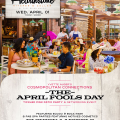April Fool’s Day, celebrated annually on April 1st, is a day synonymous with good-natured pranks, elaborate hoaxes, and boundless laughter. While the exact origins of this playful tradition remain shrouded in mystery, April Fool’s Day has become a beloved custom observed in cultures worldwide.
Theories on the Origins of April Fool’s Day
Several theories attempt to pinpoint the beginnings of April Fool’s Day. Here are some of the most prominent:
- Calendar Change: One popular theory suggests that April Fool’s Day traces back to 1582 when France switched from the Julian calendar to the Gregorian calendar. This shift moved New Year’s Day from around April 1st to January 1st. Those who failed to adapt or were unaware of the change were labeled “April fools” and became targets of lighthearted jokes and pranks.
- Vernal Equinox: Another theory links April Fool’s Day to the unpredictable weather patterns around the spring equinox. Mother Nature “fooling” people with changeable weather might have inspired the tradition of playful deception.
- Ancient Festivals: Some historians theorize that April Fool’s Day echoes ancient Roman festivals like Hilaria, which celebrated rebirth and involved disguises and merrymaking.
April Fool’s Day Traditions Around the World
The spirit of April Fool’s Day transcends borders, with playful variations observed globally:
- France and Belgium: In these countries, the tradition involves sticking paper fish on people’s backs as a playful prank. The victims are referred to as “poisson d’avril” (April fish), representing gullibility.
- Scotland: Scotland boasts a two-day April Fool’s celebration. The first day is dedicated to “hunting the gowk” (cuckoo), involving sending someone on a nonsensical errand. The second day is “Tailie Day,” devoted to pranks focused on the posterior.
- Poland: Prima Aprilis in Poland is marked by elaborate hoaxes, pranks, and a general atmosphere of lighthearted mischief.
- Other Countries: Many other countries around the world – including England, Ireland, Italy, and various Spanish-speaking nations – have embraced the joyful spirit of April Fool’s Day with their own unique twists and playful customs.
Famous April Fool’s Day Pranks Throughout History
History is brimming with notorious and memorable April Fool’s Day hoaxes:
- The Spaghetti Harvest: In 1957, the BBC aired a news segment detailing a bountiful spaghetti harvest in Switzerland due to favorable weather and the elimination of the “spaghetti weevil.” Many viewers believed the hoax.
- The Left-Handed Whopper: In 1998, Burger King announced a new burger designed specifically for left-handed individuals. The ad sparked a flurry of orders.
- Taco Liberty Bell: Taco Bell’s 1996 full-page ad claimed they’d purchased the Liberty Bell to reduce the national debt and were renaming it the “Taco Liberty Bell.” Concerned citizens flooded the National Park Service with calls.
Modern April Fool’s Day
Modern-day April Fool’s Day has grown in scale thanks to the power of media and the internet. Companies and news outlets regularly participate in playful deception, crafting elaborate and often believable hoaxes that capture the public’s attention.
Tips for a Successful April Fool’s Day Prank
If you’re keen to join the fun, here are some tips for a memorable April Fool’s Day prank:
- Keep it lighthearted: The best pranks are harmless and evoke laughter rather than offense.
- Timing is key: Reveal your prank before the day ends to avoid ongoing misunderstandings.
- Originality counts: A unique and creative prank stands out from the crowd.
Let the Laughter Commence!
Whether you’re a seasoned prankster or simply appreciate a good laugh, April Fool’s Day is a cherished tradition that reminds us of the importance of humor and lightheartedness in our lives.






